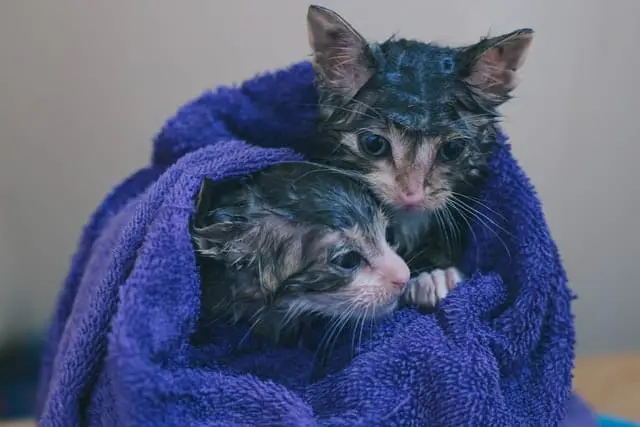
The cat is one of the cleanest pets out there and spends a large part of its hours grooming itself. This feline can be perfectly all its life without taking a bath, because for them it is enough that he comb it daily. But sometimes, they can be really dirty and need a bath. But how do cats bathe?
When to start bathing a cat
All cats are cleaned regularly. The mother licks her cubs daily to keep them clean and neat. Later they do it themselves, even to other members of the “family pack”.
It is best to start bathing a cat when it is still small and easy to handle. It should also be done by one person. Another pair of hands may scare them and the cat may resist and try to run away.
Where to bathe a cat
The ideal place to bathe your cat is a sink or bowl that is about waist level. The most comfortable height is that of the sink or kitchen sink .
Cats will quickly freak out if you put them on level ground and look at them from above. In this awkward posture, they are also more difficult to catch and control if they struggle.
Don’t worry though if it’s scared at first and wants to hold onto whatever it takes to get out of the water. We must reassure it as we explain below.
What do I need to bathe a cat
Prepare the flea shampoos, gels or lotions that you will need and two towels, one soft for the face and one large for the rest of the body. Keep these items close at hand, but out of the cat’s reach.
The shampoo you choose will depend on the type of hair your cat has. A bleach shampoo is recommended for white cats. For cats with skin problems or infested with fleas, you should use a suitable flea formula.
You can also use baby shampoo and give a last pass with a good conditioner.
If your cat has greasy hair, use a bay leaf or turpentine conditioner to remove it. If it has spots and a light coat, use 90 ° rubbing alcohol.
Do not clean its ears when you bathe them, as it is better to do it separately. Some experts advise plugging the ears with cotton so that no water can get into them. This practice is not convenient, since the cat could get scared.
Others advise smearing the eye contour with petroleum jelly to prevent shampoo from getting in. It’s also not good advice, because the foam comes in anyway.
Also, the jelly is annoying and the cat will try to remove it by making things more difficult for you. On the other hand, it is likely to spread through the fur.
Once you have everything prepared, then start bathing your cat.
How to bathe a cat
Before bathing, put a mat in the bottom of the sink or tub. Fill it with warm water until it covers the cat’s paws.
Put the cat in the water with its back to you. Never put it facing you, because it can grab onto your clothes or arms before you have time to react to try to get out of the water.
If you put it in the water with all four legs at the same time, the cat will usually stay where it is.
Then hold the breast with one hand, very gently (it can be very resistant if the pressure is excessive), and use the other hand to wet it and apply the shampoo. Never hold it by the neck or neck.
It is certain that a kitten would calm down, as it is used to being subjected to its mother in this way, but the adult cat will increase its resistance. Move slowly and speak softly.
Do not wash its face while you are bathing them. It is more convenient to do it with a wet cloth when you clean the ears.
After lathering, rinse off the shampoo by pouring water over a glass or using a telephone-type shower. Rinse it thoroughly. Otherwise, its mouth will foam when it licks its coat after bathing.
If you use conditioner, be sure to leave it rinsed out well. Next, remove the cat from the container, wrap it in the towel, and take it to a room that does not have any drafts.
If the animal trembles with fear or anxiety, put it on your lap and let the towel soak up the water while you talk to reassure it.
Dry cleaning a cat
If you do not feel able to bathe your cat, or if your cat has contracted an infection or it is very cold, it may be better to dry clean it. There are a number of dry shampoos for sale.
Sprinkle the cat’s hair with the product and brush it off. Remove any traces of shampoo with a towel. Cats hate having foreign agents in their hair, and dry shampoo can be very irritating to them.
How to dry a cat

At this point it is possible to distinguish if your cat is short-haired or long-haired. The latter take much longer to dry and take more work:
How to dry a shorthair cat
If the weather is nice and the cat has short hair, allow it to dry in one room on its own. However, do not open the windows until the animal is completely dry. A draft, even warm, can be very harmful to them.
Keep in mind that if it is very fearful and freaks out with the dryer, do not use it. It would become very nervous and may associate the bathroom with the hairdryer, putting up more resistance in the future.
How to dry a long and semi-long haired cat
If your cat has semi-long or long hair, it is not advisable to let it dry on its own and you will have to intervene in the process. As it dries, you should brush it continuously to prevent tangles from forming.
If you start doing it when the cat is small, it will quickly get used to the dryer, which will speed up the process in a spectacular way.
Whether or not you use a dryer to dry your cat’s hair, you should brush it until it has dried completely.
If the animal is not sitting still while you are combing it with one hand and holding the dryer in the other, you will need to go to someone else for help. Try to come up with a method of attaching the dryer, or purchase an inexpensive stand-up method from a pet store or online.






